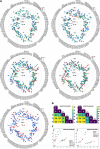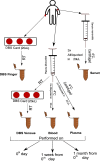Four-dimensional trapped ion mobility spectrometry lipidomics for high throughput clinical profiling of human blood samples
- PMID: 36806650
- PMCID: PMC9941096
- DOI: 10.1038/s41467-023-36520-1
Four-dimensional trapped ion mobility spectrometry lipidomics for high throughput clinical profiling of human blood samples
Abstract
Lipidomics encompassing automated lipid extraction, a four-dimensional (4D) feature selection strategy for confident lipid annotation as well as reproducible and cross-validated quantification can expedite clinical profiling. Here, we determine 4D descriptors (mass to charge, retention time, collision cross section, and fragmentation spectra) of 200 lipid standards and 493 lipids from reference plasma via trapped ion mobility mass spectrometry to enable the implementation of stringent criteria for lipid annotation. We use 4D lipidomics to confidently annotate 370 lipids in reference plasma samples and 364 lipids in serum samples, and reproducibly quantify 359 lipids using level-3 internal standards. We show the utility of our 4D lipidomics workflow for high-throughput applications by reliable profiling of intra-individual lipidome phenotypes in plasma, serum, whole blood, venous and finger-prick dried blood spots.
© 2023. The Author(s).
Conflict of interest statement
The authors declare no competing interests.
Figures








References
-
- Chang C-Y, Ke D-S, Chen J-Y. Essential fatty acids and human brain. Acta Neurol. Taiwan. 2009;18:231–241. - PubMed
Publication types
MeSH terms
Substances
Grants and funding
LinkOut - more resources
Full Text Sources

